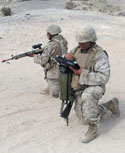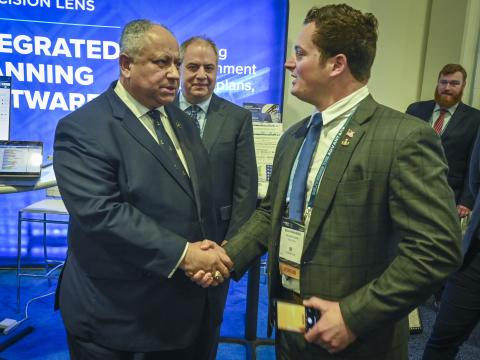Air Vehicles Deliver Warrior Data
Units caught up in urban combat patrols access real-time surveillance imagery. 
Members of the 3rd Battalion, 7th Marines, participate in an urban combat exercise at Twentynine Palms, California. One Marine provides security while the other uses a tablet computer to control various unmanned aerial vehicles (UAVs) available immediately for surveillance and reconnaissance. For the Defense Advanced Research Projects Agency (DARPA), Northrop Grumman is developing the Heterogeneous Urban Reconnaissance, Surveillance and Target Acquisition (RSTA) Team, or HURT. This system autonomously prioritizes multiple requests and directs the most suitable UAVs to required locations.
Soldiers operating in built-up neighborhoods can receive more timely and complete information about enemy forces by harnessing low-flying unmanned aerial vehicles. An autonomous system emerging from development in a far-reaching program coordinates delivery of video from unmanned aerial platforms and other military reconnaissance assets.
As a result of this Defense Advanced Research Projects Agency (DARPA) program, soldiers and Marines with handheld computers can request information about suspected enemy positions. The system prioritizes requests and directs individual unmanned aerial vehicles (UAVs) to obtain and deliver this information. Called HURT, for Heterogeneous Urban Reconnaissance, Surveillance and Target Acquisition (RSTA) Team, this capability is being demonstrated successfully in the field.
Dr. Michael A. Pagels is the HURT program manager within DARPA’s Information Exploitation Office. Most small combat units engaged today in urban warfare have no direct access to reconnaissance and surveillance data, nor can they control high-altitude aircraft or satellites that collect it. HURT allows a warfighter to directly request information critical to battlefield success. This system also allows the soldier to ask for and obtain reconnaissance imagery from any sensor system available.
Northrop Grumman,
By coordinating collections of small, quiet UAVs deployed above an urban combat area, HURT manages the diverse capabilities of a wide range of airborne sensors. With synchronized planning and control of each UAV, the system uses non-proprietary network-centric Web-based tools, Pagels explains. Under an $11.6 million Phase 1 contract from DARPA, Northrop Grumman provided the development system and used it during a two-week demonstration in October 2006 at the
Before beginning his work at DARPA, Pagels spent more than a dozen years in industry developing microcomputer and personal computer operating systems and office automation technology. He earned a bachelor’s degree in computer science from the State University of New York and a master’s and doctorate in computer science from the
“The 3rd Battalion, 7th Marines, along with an industry, government and academia team led by Northrop Grumman, confirmed HURT’s capabilities during regular training exercises in an urban environment,” Pagels declares. The development team includes Honeywell Laboratories, SRI International, Teknowledge Corporation and AeroVironment as well as researchers from NASA and the U.S. Army. The area of operations in the desert encompassed a 4-kilometer x 4-kilometer box with a forward operating base and included mountainous terrain.
 |
| An aerial mosaic view from the DARPA Wasp micro air vehicle displays an urban area of interest during a training exercise using the DARPA HURT system. This system autonomously tasks any nearby unmanned aerial vehicles to quickly perform RSTA missions. |
Depending on the mission priority, when one UAV runs low on power, another can be reassigned to loiter over the same coverage area. The vehicle’s operator remains in the loop and is informed when the UAV is being returned for a new battery. The operator also is asked whether an automated or manual landing is to be accomplished, and that operator always remains in the loop. HURT can use the auto-land system in most UAVs with stored landing, rally and loss of communication points, Pagels relates. “The warfighter interacts with the system through a handheld device to request services, including aerial, route and path surveillance; site or point monitoring; and target tracking—all with a few taps on a touchscreen tablet. In response, HURT prioritizes the requests, tasks the appropriate vehicle and delivers stabilized UAV images directly to the warfighter,” he confirms.
Imagery from HURT is provided in a number of forms, including mosaic, to provide persistent wide-area views and enhanced situation awareness, Pagels discloses. “Over the two-week training exercise, the Marines took the opportunity to integrate HURT technologies into their training exercise. They found the system easy to use, requiring no formal training to effectively employ its capabilities. Through Phase 1 of the program, HURT has proved it is a viable and essential tool in delivering actionable intelligence required to overcome urban threats.
“With no specific UAVs of its own, HURT is designed to be agnostic, using any platform available to take feeds of requested imagery,” Pagels continues. “We can work with the Army’s Raven and Raven B, DARPA’s very quiet and low observable Wasp micro aircraft, the Marine Corps’ Dragon Eye or the Pointer. During the Marine Corps demonstration, four UAVs were employed each day flying two sorties each,” he says. While UAVs were airborne, requests from troops on the ground for surveillance of areas or specific locations were quickly converted into a mission. The coordinator always has the option for manual operations, overriding HURT. However, that requires specifying the airspace because the system may be flying other platforms in the same airspace.
“We do not modify the aerial platform or the groundstation, requiring only that a groundstation have an external interface that will allow us to replace the joystick with a software interface,” Pagels states. “Most of the UAVs, up to Global Hawk, have that capability, and our software doesn’t have to modify anything; it just knows how to communicate with UAVs. Imagery feeds from the platforms come directly to the groundstation. We tap into the groundstation to get a video feed, adding value to that capability at the platoon or company level.”
Generally, groundstations for small UAVs do not have a video record capability—the imagery is ephemeral. HURT acts like a video recorder to capture the imagery, pause it, rewind it and play it back. If two UAVs are providing surveillance in the same area, the imagery from both can be viewed on a single map with a paint-brush-like effect that allows steady updates, Pagels illustrates.
As the program progresses, HURT eventually could be used with larger UAVs such as the RQ-4 Global Hawk, RQ-1 Predator, RQ-5A Hunter, RQ-8 Fire Scout vertical takeoff and landing tactical platform and the X-47B joint unmanned combat air system. DARPA is seeking to transition the technology from HURT to the Army, which has a number of UAV programs, or the Marine Corps, and the agency also is trying to miniaturize the system to fit into a backpack or for use on vehicles to control UAVs while on the move.
HURT achieves unrestricted interoperability among heterogeneous collections of unmanned platforms. The program is structured with its coordinated autonomy to provide immediate imagery and access to the lowest level warfighter—that soldier about to turn a corner or head down a road without prior reconnaissance. They need to know what those areas looked like 3 minutes ago. This is why HURT is being developed.
Web Resource
DARPA HURT program: http://dtsn.darpa.mil/ixo/programs.asp?id=38



